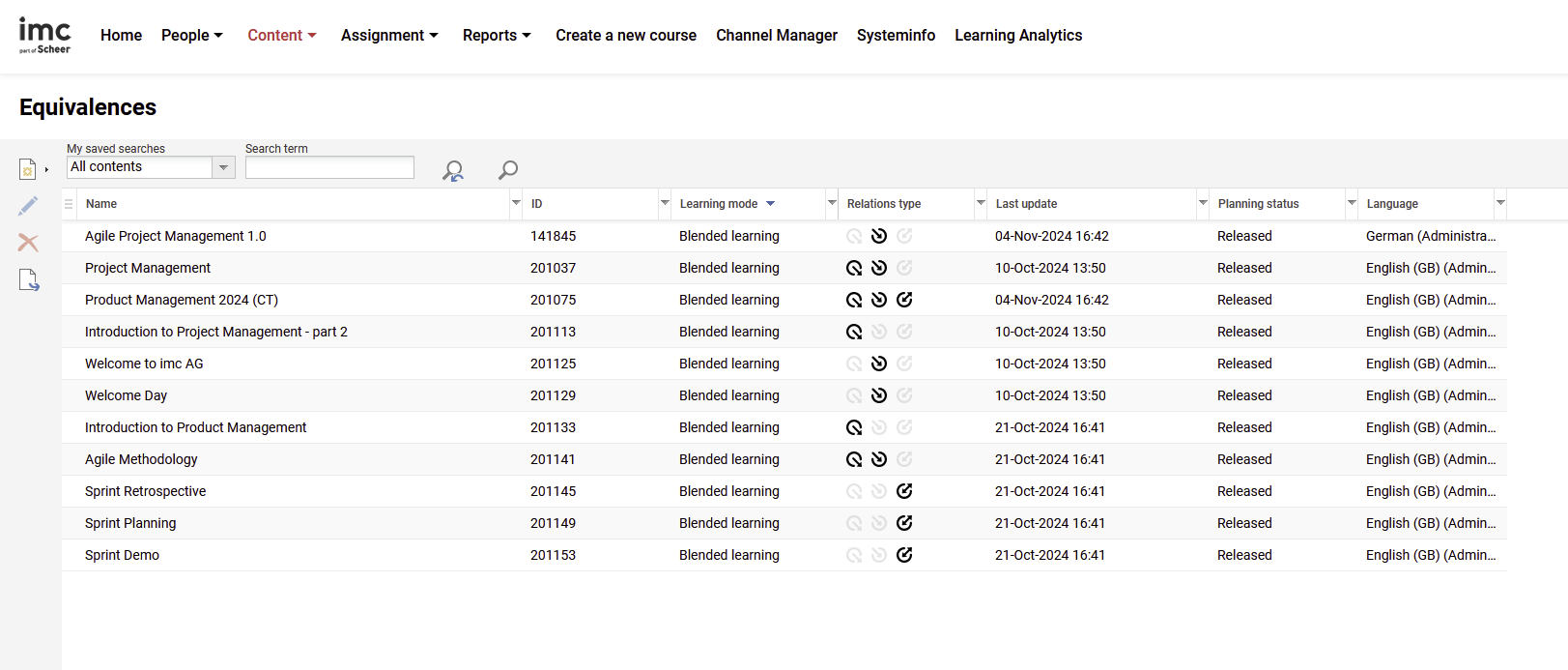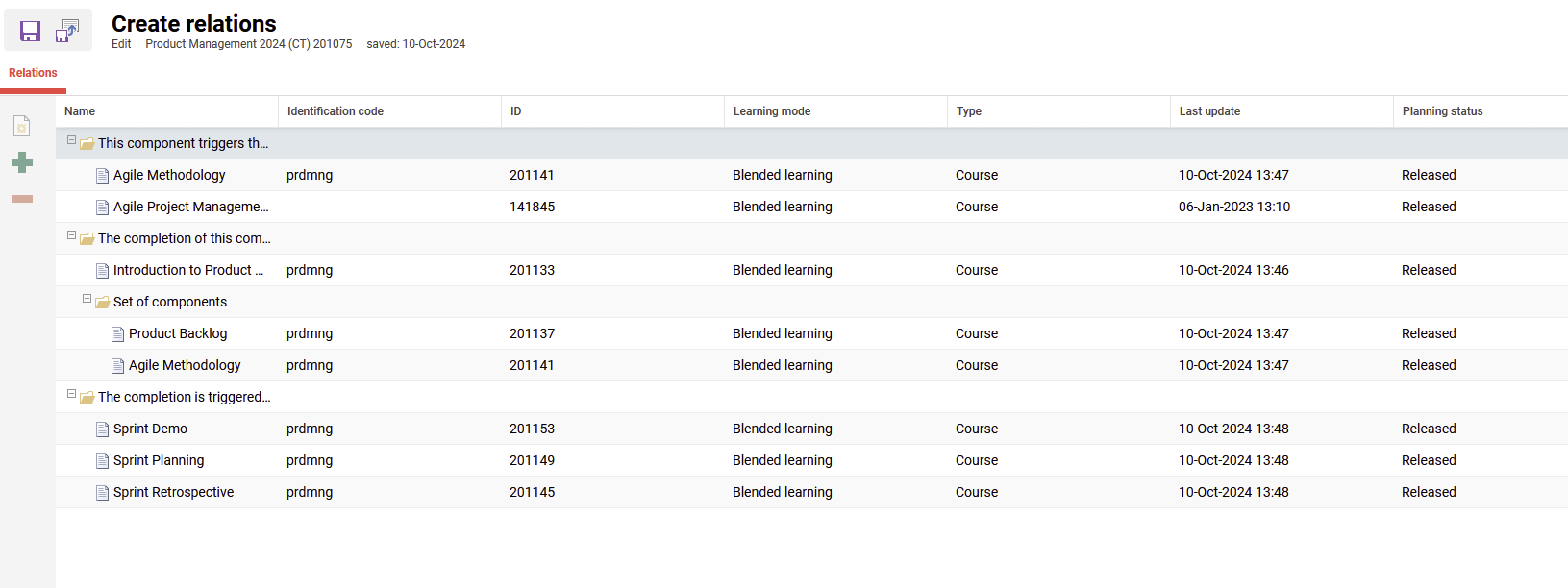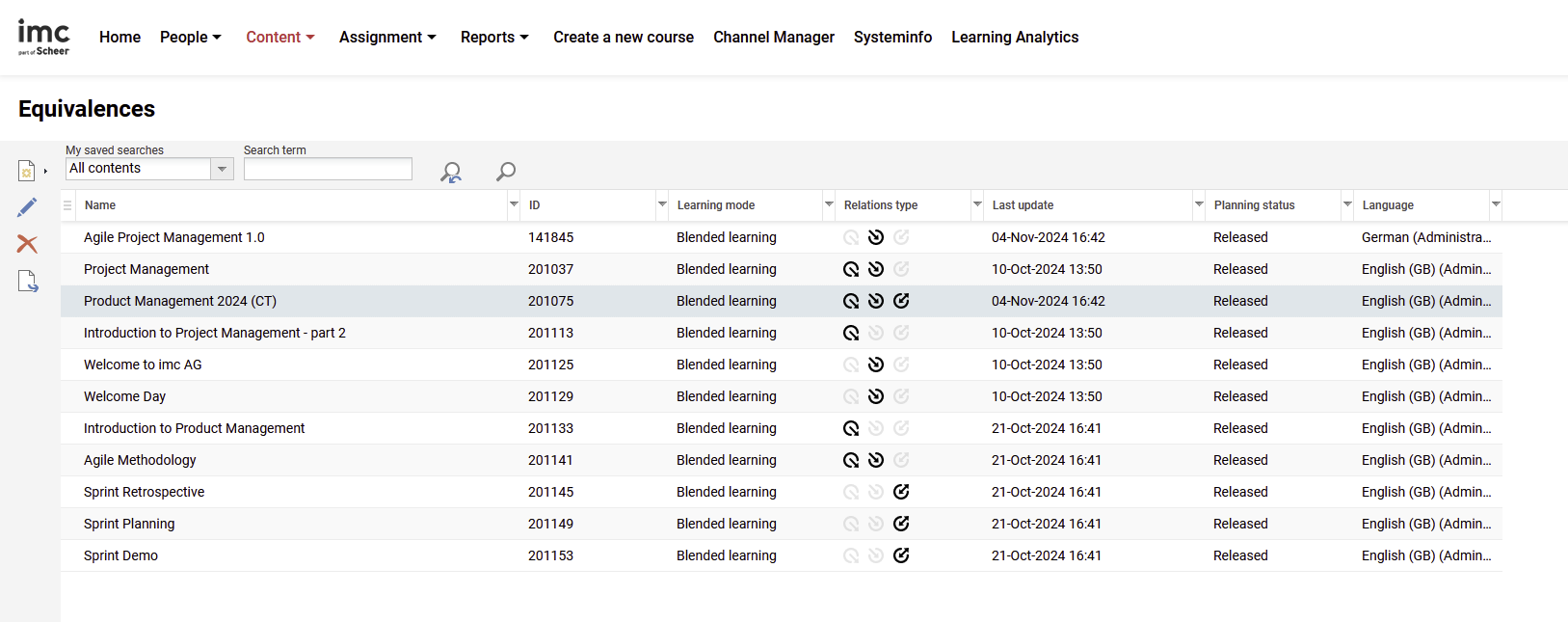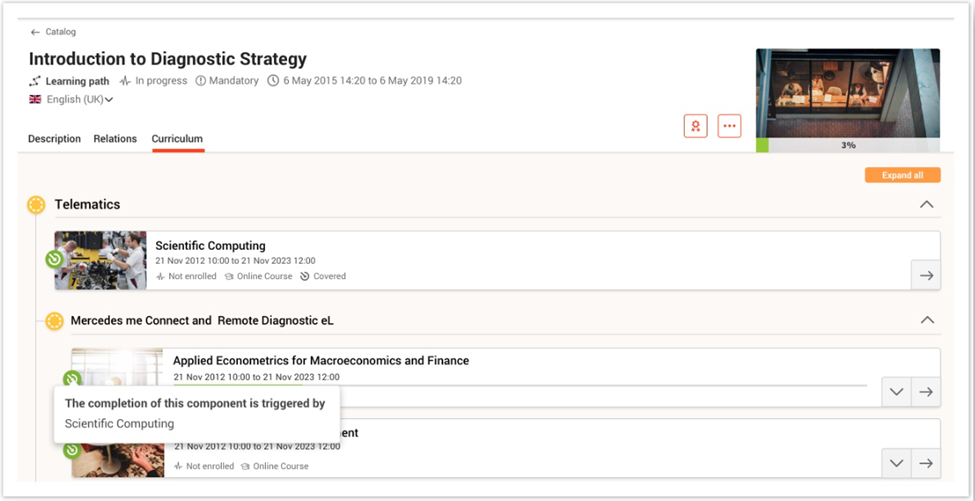Equivalences
Equivalences feature enables administrators to define relationships between courses or templates that contain overlapping or equivalent content. This is particularly valuable in large or complex learning environments where multiple courses cover similar competencies, are offered in different formats (e.g., virtual vs. in-person), or evolve over time.
What organizations gain from configuring Equivalence rules
Eliminate redundant training by automatically marking related courses as "Covered" when a learner completes an equivalent one.
Accelerate learner progress by recognizing previously acquired knowledge, certifications, or versioned content.
Maintain curriculum flexibility by allowing learners to voluntarily enroll in Covered courses for review or additional practice—without requiring them to.
Simplify compliance tracking by ensuring learners are credited for meeting learning objectives, even if course formats or versions change over time.
Support diverse learning paths by recognizing different combinations of courses as valid alternatives for a shared learning outcome.
Use Cases
There are two use cases:
One course is replaced by another course with updated content and the learners must not be required to re-take the similar content. However, they should still be able to re-take it if they wish (A = B).
Some courses are a combination of other courses. In this case, the learner can be required to take either the overall course or the courses from that it is combined but not both (C = A + B).
Currently, all equivalences are bidirectional, which means, there are no use cases where A is equivalent to B, but B is not equivalent to A.
The multiple equivalence relation is possible, meaning that taking course A gives the learners credit for course B and C, taking course B gives the learner credit for both A and C, etc.
Equivalences are valid for all processes and trigger them accordingly, e. g. if a course is used as a prerequisite for another or assigned to a learning path.
However, the course passed by the equivalence is not considered as a course passed directly: it does not appear in the learning history, it can still be started and completed by the learner (but it is optionally and never required). Therefore, the new flag "Covered" is introduced.
Equivalences functionality is part of the base license, no additional add-on components are required to be purchased in order to use it.
Functions in the Equivalences Administration
A new manager is available that allows defining equivalence relations between courses and course templates.

Equivalences Manager View
On the start page of the manager, all available equivalence relations are displayed. This list is paginated with a default number of 50 elements on page. Search is also available and can be done by Name, Identification code, Description, Object ID. The following columns are also available and they can be activated or deactivated from expanding the Columns section: Name, Identification code, Learning mode, Relations type, Last update, Planning status, Language
An element is present in this list as long there is at least one type of relation defined for it.
New
NewFurther equivalence relations can be defined.
The user has the possibility to add a new component and define relations for it:

Setting up an equivalency relation
By selecting the "+" button, a selection of course templates and courses is available.
The list is paginated with a default number of 50 elements per page. The list can be searched by Name, Identification code, Description, Object ID. The available columns are: Name, Identification code, ID, Learning mode, Last update, Planning status, Language. Then can be activated or deactivated from clicking on the arrow and selecting Column section.
At this stage, only one component can be selected.
After making the selection and clicking on Add, the edit mode will open, which allows the possibility to define the equivalence relations for the selected component.

Relation Configuration
Categories of Equivalence Relations
Category 1 → Triggers completion of → (Covers)
Goals: Defines which learning items (courses or templates) are automatically credited when a primary course is completed.
Benefit: Reduces unnecessary effort, shortens time to compliance and simplifies learner experience..
Rules/Constraints
Administrators can only select individual items to be marked as Covered. No grouping or complex logic (eg: sets).
One-way relationship: Completion of the main course triggers coverage of the others — not vice versa.
Category 2 → Completion triggered by (Is covered by)
Goal: Defines which courses or templates must be completed (individually or in combination) for the target course to be automatically marked as Covered.
Benefit: Enables flexible learning strategies, supports microlearning, and aligns with competency frameworks.
Rules/Constraints: Allows both simple OR and complex AND/OR combinations (eg: sets).
Category 3 → Mutual equivalence (Both ways)
Goal/Behavior: Defines a bidirectional equivalence between two learning items, where completing either one covers the other.
Benefit: Minimizes duplicate effort across global or multi-brand learning programs, ensures continuity during course migration or rebranding (eg: when companies offer regional, language, or vendor-specific variants of the same content, or when transitioning between course versions).
Rules/Constraints: Completing either item marks the other as Covered.

Example of relations in Equivalences Manager
"Covered" is not an enrollment status, but an additional information which, when applicable for a user, will determine that the user has already completed objects which determine in turn that the component marked as "Covered" does not need to be processed anymore.
However, if the learner chooses to, he can still enroll and process that component.
Adding items to a preferred relation is done in the following way. User has to select a folder (each relation has the corresponding folder dedicated) and then click on “+” button where he/she can select either courses/course templates or by clicking on “New” button where set of components can be defined (excluding the 1st rule for which is not possible).
After defining all the needed equivalence relations, the changes can be saved.
By selecting Save, the defined equivalence relations are created and the user is redirected to the start page of the manager, showing the outcome.
For each object that did not previously have any relation defined, an entry in the manager will be now available.
Sets of components: Adding multiple components via add component creates an OR relation between them. The components added within a set have an AND relation.
When a course template is set to covered by an equivalence rule, all courses from this template will be set to covered.
The coverage rules defined for a template apply for all versions of the template. It will not be possible to define different coverage rules for different versions of the course template.
Learning path: All components that are marked for the learner as Covered, are displayed accordingly.
Import
Edit
EditWhen editing such an entry from the manager, the defined relations for that object will be visible:

Example |
The following equivalence relations have been defined for an object: Object A
When saving this configuration, instead of one entry in the manager (for Object A), we will have 5 entries, one for each of the components that, as a consequence of the defined rules, have now equivalence relations themselves. When editing Object E for example, there will be one relation available in the third category for this element, namely the equivalence relation with Object A. Editing Object C, we will see for this object in the Second category that it covers Object A. |
Delete
DeleteAt the start page level, where all objects that have equivalence rules defined are displayed, the admin has the possibility to select one or more entries and remove them.
This will have as effect deleting also associated entries that will therefore be left without any equivalence relation.
In the example above, when I delete object A, all 5 entries will be deleted.
Equivalence Export
The equivalences manager provides also the possibility to export the rules via a dedicated export button available in the action bar.
The export is a csv export that can be opened and converted to a table in MS Excel by using the function Text to Columns.
The exported file will contain the rules in the following order: Last updated > descending.
Equivalence Import
For a correct import of the equivalences rules into the system this file containing the instructions should be used → Equivalency Import.pdf
Handling ACLs within the Equivalences Manager
Only the courses for which the user has at least Execute ACL will be visible in the manager.
The rule can be edited and deleted though the user does not have access to all components.
User will not see the courses for which he had NO ACL in the manager, nor in the export file.
Impact of the Equivalences Functionalities
Impact of the Equivalence Relation Definition
Based on the available equivalence relation rules, the outcome is that courses and course templates will be marked for learners as "Covered".
Impact in the Learning Path
All components that are marked for the learner as "Covered", are displayed accordingly.

The outcome is also that the "Covered" component will count towards the progress, even if it is not completed by the learner.
Prerequisite Handling
When courses/clusters or course templates are available as prerequisites for other courses or learning paths, the prerequisite object will be considered fulfilled if the user has this object covered.
There is no visual distinction on the prerequisite overlay screen indicating that the object is only covered and not fully completed. The prerequisite which is covered will be displayed as fulfilled.
Equivalences Behavior for Courses and Course Templates
A covered Course template has as effect that all courses created from any version of the template are set to covered as well. It will not be possible to define different coverage rules for different versions of the course template.
When a specific course is covered based on a rule, that course will be set to "Covered" if the other conditions apply, but it will not have as effect the propagation of coverage to the template or the other courses created from the same template.
Limitations
The columns in the manager are fixed and no advanced search or filtering is possible.
It is not possible to define clearances for the rules created in the manager.
Media assigned to a course cannot be passed by equivalence.
If skills are assigned to an entity passed by equivalence but not to the entity passed by the learner directly, these skills are not set to achieved.
At this point we don’t offer the possibility of searching by courses which are included in an equivalence relation. Only the icon which is displayed on the Catalogue and Description pages for the corresponding courses/course templates is the indicator for the Equivalences function.
Test Cases
WHEN | AND | THEN |
Case 1 | ||
Object A covers Object B | Object A is completed for participant X | Object B is covered for participant X |
| Object A is cancelled/ not completed for participant X | Object B is uncovered for participant X |
Case 2 - Coverage by alternative components | ||
I add the following set of rules: Object A is covered by Object B or Object C (add Object B and Object C in the second category, but not as part of a set)
The outcome in the manager will be that 3 entries are visible: Object A with the above configuration Object B → Covers Object A Object C → Covers Object A | Object C is completed and Object B is not completed for participant X | Object A is covered for participant X |
Object C + Object B are completed for participant X | Object A is covered for participant X | |
Object B is completed and Object C is cancelled for participant X | Object A is covered for participant X | |
Object B is cancelled and Object C is cancelled for participant X | Object A is uncovered for participant X | |
Case 3 - Coverage via a set of components | ||
Object A is covered by
In this case, there is only one entry shown in the manager, for Object A, since the other two objects do not define rules by themselves, and only in combination with another object. | Object B is completed and Object C is not completed for participant X | Object A is not covered for participant X |
Object B is cancelled/uncompleted and Object C is not completed for participant X | Object A is not covered for participant X | |
Object C is completed and Object B is not completed for participant X | Object A is not covered for participant X | |
Object B is completed and Object C is completed for participant X | Object A is covered for participant X | |
Object C is cancelled and Object B is completed for participant X | Object A is un-covered for participant X | |
Case 4 - Course equivalence impact on course template | ||
Course A covers Course template B | Course A is completed for participant X | Course template B is covered. this results in the fact that all courses from Course template B (in all its versions) are also covered for participant X |
Case 5 - Template equivalence | ||
Course template A covers Course template B | Course 1 from Course template A is completed for participant X | Course template A is completed and Course template B is covered for participant X All courses from the Course template B and all other versions of Course template B are also covered for participant X |
Case 6 - Changing rules | ||
Initial setup #1: Course A covers Course B and Course C and Course D | Course A is completed for participant X | Course B, C and D are covered for participant X |
| Course B is removed from the rule, resulting that Course A covers just Course C and Course D | Therefore Course B is set to uncovered for participant X |
Initial setup #2: Course A covers Course B and Course C Course E is equivalent in both directions with Course C | Course A is completed for participant X Course E is completed for participant X | Course B and Course C are covered as a result from the existing rules for participant X |
| Course C is removed from the first rule => Course A covers just Course B The second rule remains unchanged | Course B and Course C are still covered as a result from the existing rules for participant X |
Case 7 - Deleting rules in the manager | ||
I create 2 rules:
|
| In the manager we have 4 entries in this case: Course A → has two entries in the first category (Covers → Course B and Course C) Course B → one entry in the second category (Is covered by → Course A) Course C → has one entry in the second category and one entry in the third category (Is covered by→ Course A and Is equivalent in both ways with → Course E) Course E - > has one entry in the third category → equivalent in both directions with Course C |
| Course A is completed for participant X Course E is completed for participant X | Course B and Course C are covered for learner X as a result from the existing rules |
| I delete Course A from the manager directly | The remaining rules are: Course C has one entry in the third category → equivalent in both ways with Course E Course E has one entry in the third category → Equivalent in both ways with Course C The outcome is: Course C is covered, Course B is uncovered for participant X |
Case 8 - Rules with Sets of components and templates | ||
I create the following setup Course A: Covers (first category)
Is covered by (second category):
is mutually equivalent with (third category):
→ Save changes
| Course A is completed for participant X | The outcome will be: Course X and Course Z are set to covered for participant X
|
| From the first category, I remove course Z and save | Course Z is still covered for participant X, as it is present in the third category and there the equivalence also has effect. |
| I remove course Z from the first and the third category (this means Course Z has no relation to course A anymore) | Course Z is uncovered for participant X |
Case 9 - Users have already completed components before rules are created | ||
Initial situation: User completed Course A |
| No rules are defined for Course A yet, therefore no Component is Covered based on the completon of course A |
Then a rule is created in the Equivalence manager: Course A covers Course B |
| As a result of this new rule, Participant X will get Course B as covered, after the rule has been saved. (in the next minutes) |
I edit Course B and in the second category, where I can now see Course A as the only component, I remove course A and add a set of component where I add again Course A together with Course C. | Course C is not completed by the participant | Therefore, EQS sends to ILS the uncovered message for course B for participant X. Also, Course A is in this case no longer visible in the equivalence manager as it does not define by itself alone any equivalence relation, but only as part of a set together with Course C. |
| Course C is completed for participant X | As a result, Course B is now covered again for participant X |
